Moth Damage: A Growing Problem In Jacksonville FL
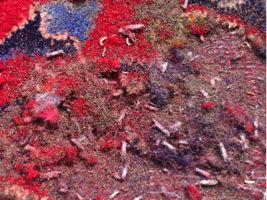 In the last several years, we’ve noticed a significant increase of moth infestation moving through Jacksonville FL area homes. This web-site was designed to give you vital information, as well as preventative maintenance suggestions. In years past, we came across moth damage in one or two houses within three months time. Now we are seeing four or more cases a week. Our research, along with advice from some of Jacksonville’s top pest control companies as well as universities throughout the country, brings us to this conclusion: case moth damage requires a clean-out process to remove infestation in all areas of the home. We have found that by the time moth larvae are eating oriental rugs, they have migrated from other infested areas in the house. It is very important to clean out moth infestation before pest control sprays are applied. We are told moth eggs cannot be killed by spraying them with pesticides alone. Active moth damage, eggs, larvae and cases must be removed by an in-depth clean-out process. Oriental rugs with moth damage must be picked up and given special attention at our plant. Professional cleaning of oriental rugs on a regular basis will prevent serious moth damage from occurring. Larson Rug Cleaning is a leader at solving the entire problem in every level throughout your home.
In the last several years, we’ve noticed a significant increase of moth infestation moving through Jacksonville FL area homes. This web-site was designed to give you vital information, as well as preventative maintenance suggestions. In years past, we came across moth damage in one or two houses within three months time. Now we are seeing four or more cases a week. Our research, along with advice from some of Jacksonville’s top pest control companies as well as universities throughout the country, brings us to this conclusion: case moth damage requires a clean-out process to remove infestation in all areas of the home. We have found that by the time moth larvae are eating oriental rugs, they have migrated from other infested areas in the house. It is very important to clean out moth infestation before pest control sprays are applied. We are told moth eggs cannot be killed by spraying them with pesticides alone. Active moth damage, eggs, larvae and cases must be removed by an in-depth clean-out process. Oriental rugs with moth damage must be picked up and given special attention at our plant. Professional cleaning of oriental rugs on a regular basis will prevent serious moth damage from occurring. Larson Rug Cleaning is a leader at solving the entire problem in every level throughout your home.
Moth Damage Rugs: How it Starts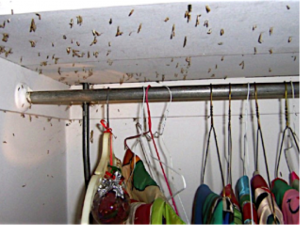
 Case making moths are attracted to places with high humidity, which explains why Jacksonville is a problem area. It is not the flying case moths that eat your rugs. Female moths lay hundreds of eggs together, which hatch into larvae and then chew their way through fabrics and rugs. Organic stains such as pet and food stains will accelerate the infestation process. Case moth larvae need protein to grow so wool mixed with an organic stains provide for the perfect snack.
Frequently Asked Questions
How can I tell if I have a moth infestation in my oriental rugs?
Examine all your wool rugs. Case moths prefer dark areas under furniture, on top of oriental rugs, and/or the back side of the rug. Move your furniture back and look on top of the rug for chewed areas where the wool might be missing. Next, look for eggs and casings. After that, turn your rug back, look along the rug edge for eggs laying on the floor or on the very edge of the rug itself. Examine the back of the rug, looking for chewed areas where knots or the overcastting (side of the rug or fringe area) might be missing. Moth eggs look like sand, but are slightly bigger and feel more rounded. Case moths that fly are small and look unstable in the air. They are about the size of a love bug and ivory-grayish in color. If you see any of this activity, you should call us
immediately.

What does the case of the moth look like?
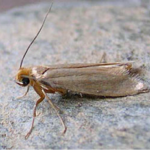
The case is the cocoon that the larvae lives in and measures about 1/8th inch wide by 1/2 inch long. The larvae looks like a worm and drags it’s case along, eating wool, silk, fur, and feathers. When they finish eating, the cocoons can be seen hanging from walls, ceilings, and furniture, as well as hiding in oriental rugs. They then “morph” into moths. Once the moths come out of their cocoons, they lay their eggs and fly away. When these new moth eggs hatch, the larvae crawl to a place to eat and the cycle repeats, multiplying the destruction.
How often should I clean my oriental rugs to prevent moth damage?
If you do not have moth damage in your house, we are recommending cleaning at least every two years. However, we find that costumers who clean their oriental rugs once a year escape from moth damage occurring in their works of art.
What about my oriental rugs that I have in storage?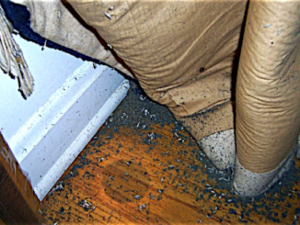
Many oriental rugs meet the fate of moth damage while they are in storage. Moth damage occurs when people just roll them up, put them in the attic, under a bed, in the closet, or in the garage and forget about them. We recommend that you inspect your rugs every six months whether they are in storage or on your floor. Oriental rugs left in storage present a great invitation for moth damage as the rugs are undisturbed for a long period of time. Also, rugs in storage that have food stains or pet contact provide an even larger invitation for moths which compounds the issue. We see moth damage repeatedly when customers show us their rugs in storage. The shame is that the damage could have been avoided with proper care. Moth damage prevention is simple… have your rugs professionally inspected, cleaned, treated and then wrapped for storage.
Will moth traps take care of moth infestation?
When using moth traps, only the flying male can be caught, which lets you know they are hatching from other areas of the house. Moth traps do not stop the larvae from chewing or prevent the on-going egg-laying process during an infestation. When male moths are caught in traps, this lets you know females are out laying eggs somewhere else in the house. Female case moths stay close to the floor walking or short hopping, moving out to other rooms to lay eggs. One female can lay 30 to 50 eggs at a time and can spread the eggs almost a foot. Female case moths can either walk in circles or in a straight line while laying her eggs. Case moth eggs can hatch in 10 to 14 days or longer, depending on the conditions and then turn into the fiber-eating
larvae.

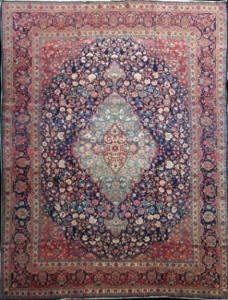 Protect your investment
Protect your investment
Searching out and finding moth damage early will save you several thousand dollars of destruction throughout your home. If moth infestation is left unattended, it will result in devastation to anything it comes in contact with.
Larson Rug Cleaning will locate and remove moth damage from your oriental rugs and do preventative cleaning for you. If damage is found, we will remove eggs, larvae, and cases from oriental rugs at our cleaning plant.
If you have oriental rugs and would like us to inspect them for moth damage, contact us anytime. The valuable information we share with you will help you determine if you have active damage in progress as well as how to prevent this kind of destruction.
